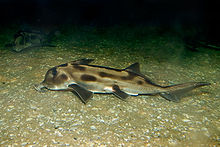
Chondrichthyes is a class of jawed fish that contains the cartilaginous fish or chondrichthyans, which all have skeletons primarily composed of cartilage. They can be contrasted with the Osteichthyes or bony fish, which have skeletons primarily composed of bone tissue. Chondrichthyes are aquatic vertebrates with paired fins, paired nares, placoid scales, conus arteriosus in the heart, and a lack of opercula and swim bladders. Within the infraphylum Gnathostomata, cartilaginous fishes are distinct from all other jawed vertebrates.
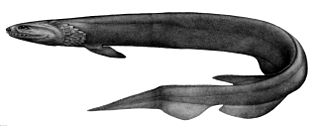
The frilled shark, also known as the lizard shark, is one of the two extant species of shark in the family Chlamydoselachidae. The frilled shark is considered a living fossil, because of its primitive, anguilliform (eel-like) physical traits, such as a dark-brown color, amphistyly, and a 2.0 m (6.6 ft)–long body, which has dorsal, pelvic, and anal fins located towards the tail. The common name, frilled shark, derives from the fringed appearance of the six pairs of gill slits at the shark's throat.

The goblin shark is a rare species of deep-sea shark. Sometimes called a "living fossil", it is the only extant representative of the family Mitsukurinidae, a lineage some 125 million years old. This pink-skinned animal has a distinctive profile with an elongated, flat snout, and highly protrusible jaws containing prominent nail-like teeth. It is usually between 3 and 4 m long when mature, though it can grow considerably larger such as one captured in 2000 that is thought to have measured 6 m (20 ft). Goblin sharks are benthopelagic creatures that inhabit upper continental slopes, submarine canyons, and seamounts throughout the world at depths greater than 100 m (330 ft), with adults found deeper than juveniles. Some researchers believe that these sharks could also dive to depths of up to 1,300 m (4,270 ft), for short periods of time.
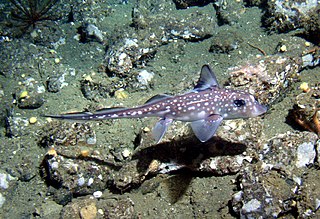
Chimaeras are cartilaginous fish in the order Chimaeriformes, known informally as ghost sharks, rat fish, spookfish, or rabbit fish; the last three names are not to be confused with rattails, Opisthoproctidae, or Siganidae, respectively.

Elasmobranchii is a subclass of Chondrichthyes or cartilaginous fish, including modern sharks, rays, skates, and sawfish. Members of this subclass are characterised by having five to seven pairs of gill clefts opening individually to the exterior, rigid dorsal fins and small placoid scales on the skin. The teeth are in several series; the upper jaw is not fused to the cranium, and the lower jaw is articulated with the upper. The details of this jaw anatomy vary between species, and help distinguish the different elasmobranch clades. The pelvic fins in males are modified to create claspers for the transfer of sperm. There is no swim bladder; instead, these fish maintain buoyancy with large livers rich in oil.

Holocephali, sometimes given the term Euchondrocephali, is a subclass of cartilaginous fish in the class Chondrichthyes. The earliest fossils are of teeth and come from the Devonian period. Little is known about these primitive forms, and the only surviving group in the subclass is the order Chimaeriformes.

The broadnose sevengill shark is the only extant member of the genus Notorynchus, in the family Hexanchidae. It is recognizable because of its seven gill slits, while most shark species have five gill slits, with the exception of the members of the order Hexanchiformes and the sixgill sawshark. This shark has a large, thick body, with a broad head and blunt snout. The top jaw has jagged, cusped teeth and the bottom jaw has comb-shaped teeth. Its single dorsal fin is set far back along the spine towards the caudal fin, and is behind the pelvic fins. In this shark the upper caudal fin is much longer than the lower, and is slightly notched near the tip. Like many sharks, this sevengill is counter-shaded. Its dorsal surface is silver-gray to brown in order to blend with the dark water and substrate when viewed from above. In counter to this, its ventral surface is very pale, blending with the sunlit water when viewed from below. The body and fins are covered in a scattering of small black & white spots. In juveniles, their fins often have white margins.

The Australian ghostshark is a cartilaginous fish (Chondrichthyes) belonging to the subclass Holocephali (chimaera). Sharks, rays and skates are the other members of the cartilaginous fish group and are grouped under the subclass Elasmobranchii. Alternative names include elephant shark, makorepe, whitefish, plough-nose chimaera, or elephant fish. It is found off southern Australia, including Tasmania, and south of East Cape and Kaipara Harbour in New Zealand, at depths of 0–200 m (0–656 ft). Despite several of its names, it is not a shark, but a member of a closely related group.

Ischyodus is an extinct genus of chimaera. It is the most diverse and long-lived chimaera genus, with over 39 species found worldwide spanning over 140 million years from the Middle Jurassic to the Miocene. Complete specimens of I. quenstedti from the Late Jurassic of Germany most closely resemble the genus Callorhinchus amongst living chimaera genera. It is sometimes placed in the "Edaphodontidae", a unclearly defined group of chimaera with an uncertain position within the clade, while other authors place it into Callorhinchidae along with Callorhinchus.
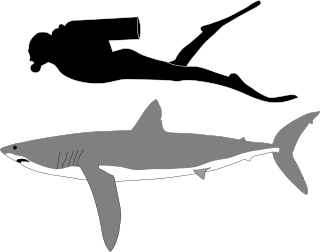
The longfin mako shark is a species of mackerel shark in the family Lamnidae, with a probable worldwide distribution in temperate and tropical waters. An uncommon species, it is typically lumped together under the name "mako" with its better-known relative, the shortfin mako shark. The longfin mako is a pelagic species found in moderately deep water, having been reported to a depth of 220 m (720 ft). Growing to a maximum length of 4.3 m (14 ft), the slimmer build and long, broad pectoral fins of this shark suggest that it is a slower and less active swimmer than the shortfin mako.
The narrownose chimaera is a longnose chimaera of the family Rhinochimaeridae, the longnose chimaeras, consisting of eight species belonging three genera. This species is found in temperate seas worldwide, at depths between 200 and 3,100 m. Its length is between 1.0 and 1.5 m, including a long, tapering snout and a long, filamentous tail.

The bigeye sand tiger is an extremely rare species of mackerel shark in the family Odontaspididae, with a possible worldwide distribution. A large, bulky species reaching at least 3.6 m (12 ft) in length, the bigeye sand tiger has a long bulbous snout, large orange eyes without nictitating membranes, and a capacious mouth with the narrow teeth prominently exposed. It can be distinguished from the similar smalltooth sand tiger by its teeth, which have only one lateral cusplet on each side, and by its uniformly dark brown color.
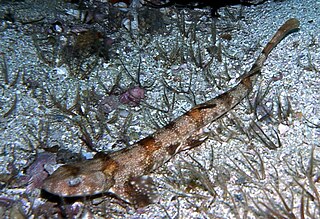
Haploblepharus is a genus of catshark, and part of the family Scyliorhinidae, containing four species of shysharks. Their common name comes from a distinctive defensive behavior in which the shark curls into a circle and covers its eyes with its tail. The genus is endemic to southern Africa, inhabiting shallow coastal waters. All four species are small, stout-bodied sharks with broad, flattened heads and rounded snouts. They are characterized by very large nostrils with enlarged, triangular flaps of skin that reach the mouth, and deep grooves between the nostrils and the mouth. Shysharks are bottom-dwelling predators of bony fishes and invertebrates. They are oviparous, with the females laying egg capsules. These harmless sharks are of no commercial or recreational interest, though their highly limited distributions in heavily fished South African waters are of potential conservation concern.

The spotted ratfish is a chimaera found in the north-eastern Pacific Ocean. Often seen by divers at night in the Pacific Northwest, this cartilaginous fish gets its characteristic name from a pointed rat-like tail. The ratfish lays leathery egg cases on the bottom of muddy or sandy areas, which are often mistaken by divers as something inanimate. While mainly a deep-water species, it occurs at shallower depths in the northern part of its range. The generic name, Hydrolagus, comes from the Greek words ὕδωρ, meaning water, and λαγώς/λαγῶς, meaning hare, and the specific name honors Alexander Collie, who was a ship surgeon and early naturalist. The spotted ratfish is common in much of its range, not typically eaten by humans, and is not commercially caught.

The puffadder shyshark, also known as the Happy Eddie, is a species of catshark, belonging to the family Scyliorhinidae, endemic to the temperate waters off the coast of South Africa. This common shark is found on or near the bottom in sandy or rocky habitats, from the intertidal zone to a depth of 130 m (430 ft). Typically reaching 60 cm (24 in) in length, the puffadder shyshark has a slender, flattened body and head. It is strikingly patterned with a series of dark-edged, bright orange "saddles" and numerous small white spots over its back. The Natal shyshark, formally described in 2006, was once considered to be an alternate form of the puffadder shyshark.
Edaphodon was a fish genus of the family Callorhinchidae. As a member of the Chimaeriformes, Edaphodon was a type of rabbitfish, a cartilaginous fish related to sharks and rays. The genus appeared in the Aptian age of the Lower Cretaceous and vanished in the Pliocene. It was most prominent during the Late Cretaceous. Many Edaphodon species were found in the Northern Hemisphere, but species from the Southern Hemisphere are also known.
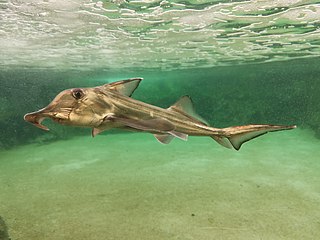
The Cape elephantfish, also known as josef or St Joseph shark, is a species of fish in the family Callorhinchidae.
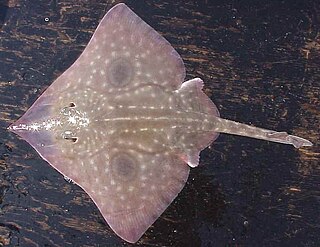
The big skate is the largest species of skate in the waters off North America. They are found along the Pacific Coast from Alaska to Baja California, typically from the intertidal zone to a depth of 120 m (390 ft), and feed on benthic invertebrates and small fishes. They are unusual among skates in that their egg cases may contain up to seven eggs each. This species is one of the most commercially important skates off California and is sold for food.

The large-eyed rabbitfish is a species of fish in the family Chimaeridae. It is found in several areas of the Atlantic Ocean and within the Mediterranean Sea.
